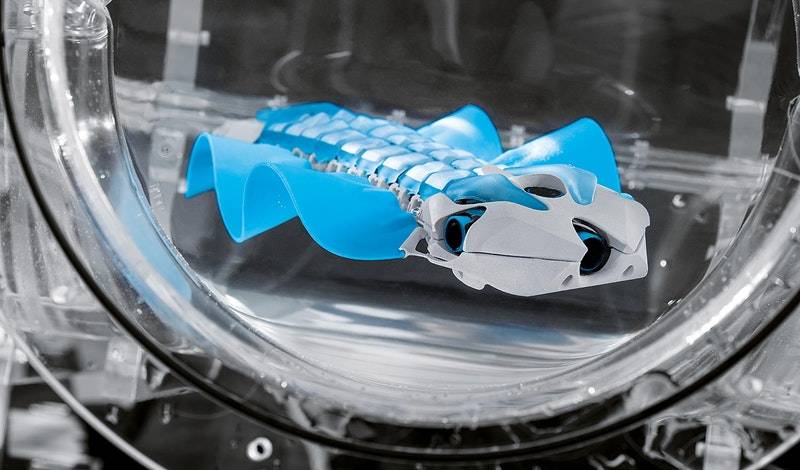[ihc-hide-content ihc_mb_type=”show” ihc_mb_who=”reg” ihc_mb_template=”3″ ]
[vc_row][vc_column][vc_column_text]Credits: www.3dprintingprogress.com
By means of ultrasound, dolphins and pilot whales are able to find their way even in dark and murky waters using their natural echo sounder. Submarines also use ultrasound technology for locating purposes. Ultrasound sensors can calculate distances, even to transparent materials and underwater. The BionicFinWave takes advantage of these properties: the underwater robot by Festo swims collision-free through a pipe system made of acrylic glass thanks to ultrasound sensors. For more information see the IDTechEx report on sensors for robotics.
Ultrasound sensors transmit sound waves in the high frequency range towards their target object, from where the sound waves are reflected as an echo. The sensors receive these signals and are able to calculate the distance using the time interval until the echo is returned. Distances can be measured and one’s own position determined using this measuring principle.
The BionicFinWave underwater robot by Festo uses the technology to swim collision-free through a transparent pipe system with its undulating fin motion. Five ultrasound sensors on its head and the inertial sensor technology constantly measure the distances to the walls and its current direction in the water. A processor analyses this data and uses it to work out when a curve in the pipe system is coming. It controls the fins in such a way that the BionicFinWave swims as centred as possible and does not hit the walls.
The BionicFinWave uses its two side fins to move along. With these, it generates a continuous wave, the so-called undulating fin movement. The wild marine planarian, the cuttlefish and the Nile perch also move through the water in this way. The wave-shaped movement of the fins allows the fish to push the water behind them, thereby creating a forward thrust.
The fins on the BionicFinWave are completely cast from silicone and do without struts or other support elements. This makes them extremely flexible and thus able to implement the fluid wave movements of their biological role models. They are each fastened on the left and right to nine small lever arms, which have a deflection angle of 45°. The lever arms in turn are driven by two servo motors located in the body of the underwater robot. Two attached crankshafts transfer the force to the levers in such a way that the two fins can move individually. They can thereby generate different wave patterns.
In order to swim in a curved line, for example, the outer fin moves faster than the inner one – similar to the chains on a digger. A third servo motor on the head of the BionicFinWave controls the flexure of the body, which helps it to swim up and down. The crankshafts and joints are made in a single piece in the 3D printing method and are therefore accordingly flexible and supple.[/vc_column_text][/vc_column][/vc_row]
[/ihc-hide-content]
The AM Chronicle Editorial Team is a collective of passionate individuals committed to delivering insightful, accurate and engaging stories to additive manufacturing audiences worldwide.



